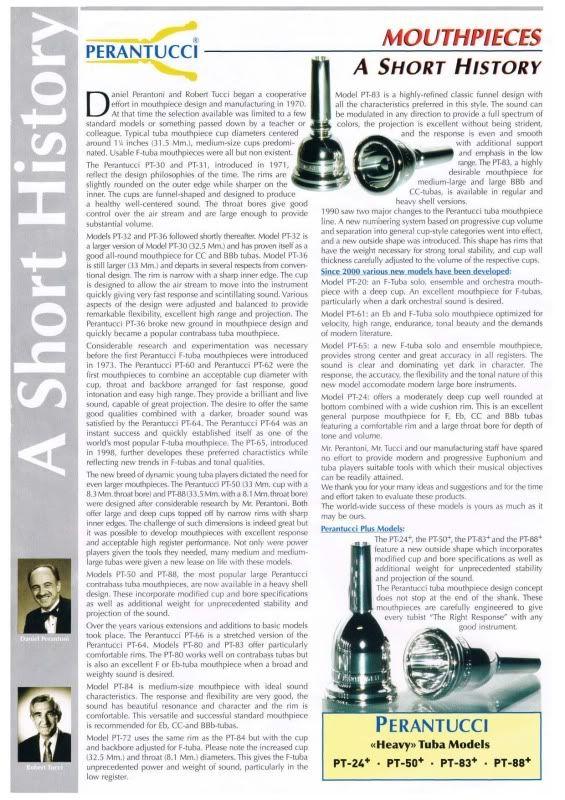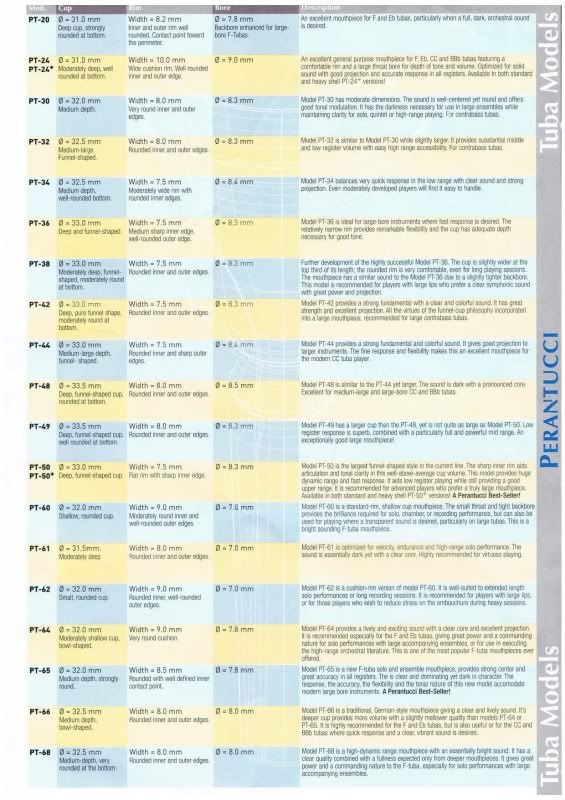Page 1 of 1
Perantucci
Posted: Mon Nov 28, 2011 1:49 pm
by Chuck Tuba
What are the differences between the models of mouthpieces in the Perantucci line?
For instance, the 50L vs. 50, 88 vs. 88+, or 65 vs. 65s. I have read each description on their website but it reads the same.
Is there a difference between the model types or is it just a selling point?
Re: Perantucci
Posted: Mon Nov 28, 2011 1:58 pm
by TexTuba
Chuck Tuba wrote:What are the differences between the models of mouthpieces in the Perantucci line?
For instance, the 50L vs. 50, 88 vs. 88+, or 65 vs. 65s. I have read each description on their website but it reads the same.
Is there a difference between the model types or is it just a selling point?
In order of asked:
*edited
Heavyweight (+)
Small Shank (s)
Re: Perantucci
Posted: Mon Nov 28, 2011 2:06 pm
by Chuck Tuba
Thanks!
Re: Perantucci
Posted: Mon Nov 28, 2011 2:16 pm
by sousakrue
The "L" Means Longer cup. They produced the PT50 with a slightly thinner rim, and a slightly longer shaped cup. The "L" does NOT mean larger shank. It's a reworked PT50.
Re: Perantucci
Posted: Mon Nov 28, 2011 2:51 pm
by Chuck Tuba
I was looking into trading my standard 50 for a 50L. I assume the longer cup would lead to more vibration and add resonance to it's sound. Is this true? If not, what difference's in playing does the 50L have over the 50?
Re: Perantucci
Posted: Mon Nov 28, 2011 4:08 pm
by Rick Denney
Chuck Tuba wrote:I was looking into trading my standard 50 for a 50L. I assume the longer cup would lead to more vibration and add resonance to it's sound. Is this true? If not, what difference's in playing does the 50L have over the 50?
There is a limit to how big a mouthpiece can be before it kills resonance rather than adding it. The mouthpiece, the player, and the instrument need to be matched to find the most resonant combination, and that may not be the largest size of any of those three.
I have used a PT-48 on my Holton, which is pretty decent. But I get even less woof and more clarity from a more Geibish shape, such as I seem to get from the Stofer Geib and the Sellmansberger Symphony. These are not small in the history of tuba mouthpieces, but they are small compared to a 50L or an 88. The Holton is big and resonant enough not to need more from the mouthpiece--it needs crispness and clarity from the mouthpiece to keep it from getting woofy.
Mouthpiece makers add new mouthpieces to their line on request, often from influential performers. Perantucci started with a numbering scheme that included only single digits (I had a PT-1 and a PT-2 for contrabass tubas, and a PT-9 for my first F tuba), but everyone wanted something different and the line grew to accommodate those variations. You have to try things out to find what works for you. It is a long search, but the first step is being able to articulate what you
don't like about your
current mouthpiece. If you can't state that plainly, at least to yourself, you'll just be adding weight to the shelf where you keep your mouthpieces. Alternatively, if you buy used and sell the ones that don't work, it's not so bad. Most tuba players end up with a quite a collection buy the time they get old. Ask me how I know.
Here's a fundamental principle which may or may not be relevant for you, depending on where you are with your playing: If you can't make a sound that is adequate to your needs using either a Bach 18 or a Conn Helleberg, then the mouthpiece isn't the problem. A mouthpiece can never solve a problem of poor fundamentals.
Rick "who has learned his lesson with toilet-bowl mouthpieces" Denney
Re: Perantucci
Posted: Mon Nov 28, 2011 5:03 pm
by ckalaher1
I had never cared for the PT-50 much, as I had almost always used the PT-88.
When I bought my PCK, I was looking for the right mouthpiece, as the 88 just didn't seem to allow for much core to the sound, especially in the low register on the horn. I tried a 50, and while it was better, it still wasn't what I wanted. After trying several others (a Blokepiece that came with the horn, the GW original Baer CC, Dillon Olka, PT-44, and a few others that I can't remember), I put in a 50L and the horn really came to life.
That has become my all-purpose CC mouthpiece since then. YMMV, as mouthpieces are obviously an induvidual thing.
Re: Perantucci
Posted: Tue Nov 29, 2011 1:28 am
by Chuck Tuba
Thanks for all the info.
I am in the process of trying mouthpieces and seeing what fits but also hindered to certain choices due to my private instructor, which I have no problem with since he is the teacher and I am the student.
I will try out a 50L and see what happens. It might be the change I need or maybe not. Only one way to find out.
Thanks for all the advice!
Re: Perantucci
Posted: Tue Nov 29, 2011 1:43 am
by bububassboner
Chuck Tuba wrote:Thanks for all the info.
I am in the process of trying mouthpieces and seeing what fits but also hindered to certain choices due to my private instructor...
May I ask why? Is there a reason your teacher only wants you to play certain mouthpieces? I really see no point in limiting a student in his/her search for a good mouthpiece. Can you explain more please?
Re: Perantucci
Posted: Tue Nov 29, 2011 8:19 pm
by Chuck Tuba
His reasons are "to get a better response and more precision on notes." Not word for word but the jist of his comment. He strongly endorses the Perantucci line, which I believe has something to do with the mouthpiece choices. I played on a GW Alan Baer MMVI CC over the summer and was switched back to my PT-50 for the reason stated above. I am no professional but have heard that a mouthpiece cannot make that type of difference to ones sound and that it is more based on personal preference, but not completely sure if that is true.
Re: Perantucci
Posted: Wed Nov 30, 2011 11:31 am
by Rick Denney
Be careful what you say about your teacher on Tubenet. Your teacher might be reading!
I can see why a teacher would limit a student's choices in mouthpieces to a standard, conventional design. That forces the student to deal with his or her issues of fundamentals without giving in to the temptation to try and solve them using equipment. I'm not sure a 50L falls into that category, though, being the biggest mouthpiece in that series.
But there are also teachers who will plug a brand for reasons of their own. Either live with it or get a new teacher. Even though I don't use Perantucci mouthpieces myself, I have used them in the past and it would be hard to defend the notion that nothing in their line is at least serviceable.
Rick "not a teacher" Denney
Re: Perantucci
Posted: Wed Nov 30, 2011 1:41 pm
by Rick Denney
bloke wrote:I have shunned teaching (surely to the benefit of hundreds who have been spared victim-hood) since having been "certified" and officially "qualified" to do so. That having been said, I would never consider recommending any mouthpiece to a currently-weaker-player-than-am-I student that I myself was not "man" enough to use. To me, the goal of good mouthpiece design is to maximize efforts. I do not view the goal of mouthpiece design as coming up with something to which players might "aspire".
I think you are missing my point, or maybe I'm missing yours.
I do no suggest a conventional design to provide an aspirational goal. I suggest a conventional mouthpiece to prevent gear acquisition syndrome (a topic about which I know quite a lot) by students who don't realize what a trap it can be. Before a player can know whether a given mouthpiece maximizes efforts, they have to have a clear idea of what they want their efforts to achieve. I think that takes good fundamentals. If a person whose inadequate air supply results in a thin sound wants a big funnel-shaped mouthpiece to achieve a round tone in spite of their inadequate air supply, then a teacher should be obligated, it seems to me, to resist the student's attempt to avoid dealing with their air supply. "Forget the mouthpiece--what you have is fine. Now, let's work on breathing..."
Such has been said to me when I deserved it, and I think correctly so.
I'm not arguing against experimentation, for which the only justification required is having the money. I'm certainly not arguing that an inefficient mouthpiece (vis a vis efforts) somehow makes us stronger. I'm merely suggesting a reason why a teacher might resist a student's mouthpiece chase.
Rick "who still has an inadequate air supply resulting in a thin sound, even with his Sellmansberger Symphony mouthpiece" Denney
Re: Perantucci
Posted: Thu Dec 01, 2011 7:39 am
by tubeast
I agree with Rick.
The other day, a guy from another community band came over and asked to test some MPs that I happen to own. He (and his conductor) figured he should get something decent and wanted some input as to what type of MP he should look into.
I had him play for me on his own equipment first. Then I gave him some hints as to how to inhale and how to form his oral cavity. He was quite enthusiastic about the IMMEDIATE success.
Following my suggestion, he decided to scrap that "get a MP"-idea for a while and replace it by "get a teacher".
There´s one thing to keep in mind, though: The OP already OWNED the Baer model MP.
In that case the "harm" of acquiring special equipment was already done. So the only reason for a teacher to advise switching away from an EXISTING mouthpiece would be an obviously bad player-MP combination, in my opinion. ("bad" as in "hindering / slowing progress / making life unnecessarily difficult"). Although being modestly priced, Perantucci MPs are by no means cheap.
Hans
Re: Perantucci
Posted: Thu Dec 01, 2011 7:47 pm
by Roger Lewis
Here's the old catalog for those who are interested in the specs.
Have fun.
Roger







